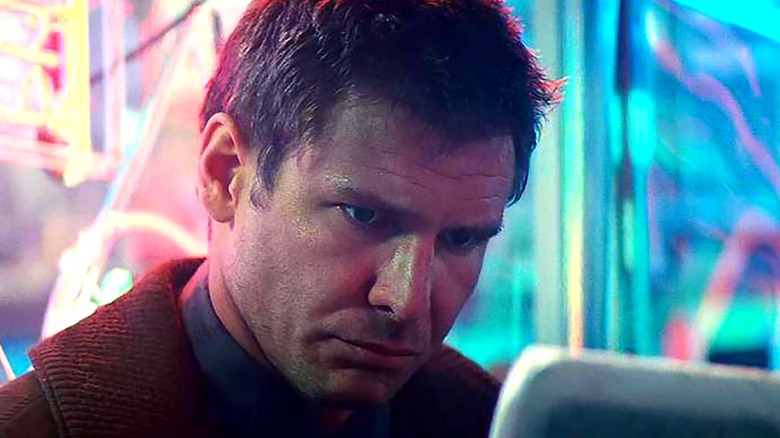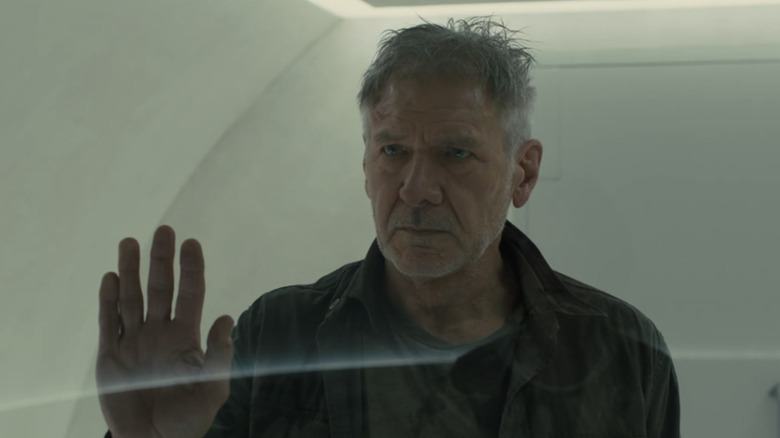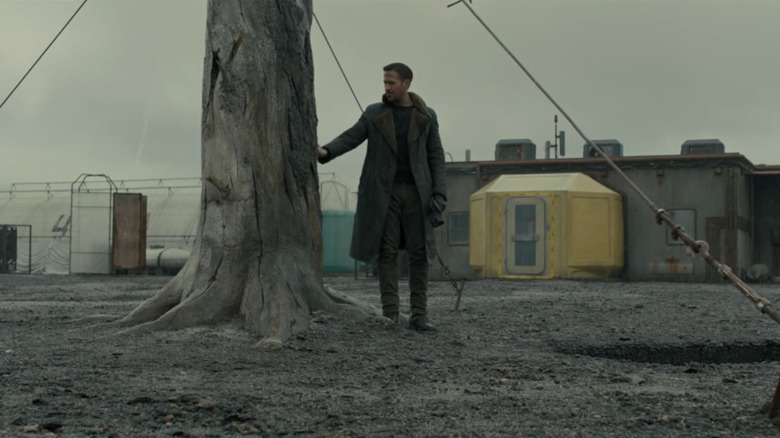Blade Runner 2: What Was 'Edge Of Human' About And Why Didn't They Film It?
In 2017, the dystopian science fiction classic "Blade Runner" finally received its long-awaited sequel with Denis Villeneuve's "Blade Runner 2049," released more than thirty years after its predecessor. However, diehard fans of the franchise will know that another sequel was actually in the works during the late 1990s. This failed sequel would have adapted the novel "Blade Runner 2: The Edge of Human" by K.W. Jeter, which acts as a continuation to both "Blade Runner" and its source material – Philip K. Dick's "Do Androids Dream of Electric Sheep?"
The book picks up several months after Rick Deckard's (Harrison Ford) escape from Los Angeles with the replicant Rachael (Sean Young), at which point the pair have relocated to a remote shack in Oregon. Deckard is later discovered by Sarah Tyrell, the human template for Racheal and the heiress to the Tyrell Corporation. She enlists him to hunt down the "missing sixth replicant" who escaped in the original film. Deckard's subsequent investigation embroils him in a massive conspiracy that pits him against fellow Blade Runner Dave Holden (Morgan Paull) and the human template for Roy Batty (Rutger Hauer), who both believe that Deckard is actually the sixth replicant.
In the end it's revealed that there never was a sixth replicant, and that Sarah Tyrell invented the story to destroy the Tyrell corporation from the inside –- resenting Eldon Tyrell (Joe Turkel) for creating the replicant Rachael. In another twist, Dave Holden discovers that the replicant Racheal was killed in Oregon, and that Sarah Tyrell herself had actually taken her place and escaped with Deckard shortly before the Tyrell Corporation's demise.
The script was written, but this sequel never made it any further
This sequel is certainly much more direct than the decades-later story we eventually got through "Blade Runner 2049," and according to contemporary sources the book attracted some major Hollywood buzz around the turn of the century.
As reported by Ain't it Cool News in 1998, the rumored script was (at the time) said to be circulating a number of script readers throughout Hollywood and was penned by writer and director Stuart Hazeldine. This report also recaps the script for "Blade Runner Down," which once again sets Rick Deckard on a new chase for the "missing" replicant from Roy Batty's offworld colony — though the story was apparently much grander in scale than the original film, tackling broad concepts about slavery, life, and human nature.
One possible reason for the cancellation of this sequel could have been the lukewarm reception this novel received when it was released in 1995; with Entertainment Weekly's Michael Glitz saying that "only hardcore fans will be satisfied by this tale," and criticizing K.W. Jeter's habit of rehashing dialogue and ideas from the film. Others, like BearCave.com critic Ian Kaplan, agreed that the book was too shallow and unsatisfying for most audiences. Another explanation for the failed film adaptation is the fact that licensing disputes over Philip K. Dick's work essentially blocked any sequels from being produced until the mid 2010s, at which time production began on "Blade Runner 2049" instead.
Blade Runner 2049 follows a completely different story, for good reason
Though one could make the argument that the story for "Blade Runner 2: The Edge of Human" at least influenced the start of "Blade Runner 2049" (since its revealed that Rachael and Deckard did end up living in a remote shack after their escape) the film makes no reference to the "missing" replicant from the offworld colony. In fact, the entire plot of "Blade Runner 2: The Edge of Human" likely wouldn't work in "2049," since most of the book is based on plot holes or continuity errors from the original 1982 theatrical cut –- including the mention of a "sixth" replicant that is forgotten later on, and the fact that the replicant Leon (Brion James) was able to bring a gun through Tyrell security.
With the majority of these plot holes being corrected in the numerous "Blade Runner" re-releases that followed its 1982 premiere (including the revered 2007 "Blade Runner: The Final Cut") it makes sense that "2049" would not incorporate the story of "The Edge of Human." Despite the failed film adaptation and the mixed reception it received, K.W. Jeter would go on to pen two more sequels following "The Edge of Human," titled "Blade Runner 3: Replicant Night" and "Blade Runner 4: Eye and Talon."
Although we will probably never know the true reason why this sequel never made it out of production hell, it's clear that "Blade Runner 2: The Edge of Human" was once making waves throughout Hollywood — and might once have been the final chapter in Rick Deckard's story, rather than "Blade Runner 2049."


